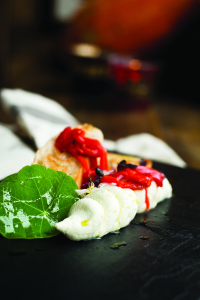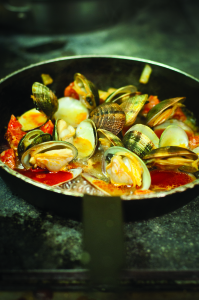On a chilly winters night a few weeks ago we had our first East Cork Slow Food event of the year. The title didn’t sound particularly appealing “How a Love Of Food And Literature Can Bring Your Life In A Different Direction†but eminent food historian Dorothy Cashman kept us riveted for several hours and whetted many peoples appetite for food history, old cookbooks and lore that they hadn’t a jot of interest in before.
Dorothy, herself had almost stumbled into what has now becoming an all absorbing hobby. Good wholesome food and convivial family meals were an important part of her childhood and stirred up as they do for many of us, nostalgic and happy memories.
In 1991 Dorothy decided to take a career break from her air hostess job in Aer Lingus to learn how to cook. After three months here at the Ballymaloe Cookery School, her interest in all things gastronomic grew and eventually 2009 she retired from Aer Lingus and in 2007 enrolled on the New Product Development and Culinary Innovation MSc in DIT in Dublin. She found herself intrigued by food history and old cookbooks and became particularly fascinated by the manuscript cookbooks of the great Irish houses. Interestingly, relatively little work had been done on this area, it was almost as through it was ‘air brushed’ out of our history. Most cookbooks including my own Traditional Irish Cooking had concentrated on the food of the poor and middle classes, simple, nourishing and often delicious but hardly sophisticated food.
However, Dorothy quickly discovered that the clichéd image of traditional Irish food was only part of the story. As in every country, the food depended on the social status and economic situation of the family. The food eaten in many of the great houses was fascinating and reflected the fresh produce of the estate. Fresh vegetables, herbs and fruit from the walled garden, orchards and greenhouses. Game during the season and fish from the local rivers and lakes or a fish pond on the estate. Several houses had a ready supply of squabs from their columbarium and there were many ice houses, some of which are still in existence. The cook, with a few notable exceptions ,was local but often incorporated recipes into their repertoire that the lady of the house had got from friends or had collected on the Grand Tour of Europe.
Fortunately, the lady of the house sometimes recorded the receipts as they were then known into a beautiful bound book in exquisite copper plate handwriting. These manuscript cookbooks are an important social record as well as a deeply personal account of what the family was eating at that point in time. They were never meant to be published or read outside of the family circle so they are invariably written in a casual unguarded style, with the occasional aside or alteration .In some instances they were written by just one person but in other cases the manuscripts were added to by several generations as in the Parsons family of Birr Castle and the Pope family from Waterford have three books in the Library (MS 34,923/1-3) and were added to by the members of the family from 1823 to c1890, book by book…
From some of the entries one might deduce that the lady of the house, not herself a cook was transcribing the cooks receipt as it was relayed to her. The cook particularly in earlier years may well have been illiterate and her mistress often had little understanding of quantities or cooking techniques so not all recipes are accurate or can be relied on to work. There’s also the possibility that some cooks didn’t necessarily want to share their secrets!
Dorothy discovered an extensive archive of manuscript cookbooks dating from 1700 to mid/late 1800 in the National Library and has since embarked on a fascinating research project, a journey of discovery where each little clue opens new doors and gives new insights into our traditions and food culture. And the fascinating families who lived in these houses, brought recipes with them from their childhood homes and collected and shared with their friends and neighbouring estates.
The mistress of the house was also expected to have remedies for all ailments from cuts and burns to cholera or whooping cough so the manuscript cookbooks also invariably included recipes for all kinds of healing potions as well as drinks and furniture or even grate polish.
It was intriguing to see recipes for preserved lemons ‘Lady Tyrone’s receipt for pickling lemons got from my grandmother’ in Mrs Baker’s manuscript.  And extensive use of spices, rose water, orange blossom water and of course barm, an ingredient which now intrigues bakers and chefs.
Dorothy, stressed that there are still handwritten recipe collections often written in simple copy books in the back of drawers or in a box in the attic in many homes, these are really worth rescuing. They may not be of sufficient interest to be part of the national collection but each is worth saving as a family heirloom.
If you think you have a manuscript cookbook that may be of interest, contact Dorothy Cashman atdorothycashman1@eircom.net.
Spellings are original.
Lady Tyrone’s receipt for pickling lemons, G.M (MS 34,952 National Library of Ireland)Â
This is from the manuscript of Mrs Baker of Ballaghtobin, who was related to the Earl of Tyrone.
Take the largest lemons, pare them as thin as possible, score them across at each end and rub them mighty well with salt for 10 days every day, then dry them at the fire or in the sun for an hour every day then put them into a close stone jar, 12 cloves of garlic, red Indian pepper and flour of mustard and sliced ginger, cover them with raw vinegar. They are apt to grow soft if not properly done therefore to keep them hard when you are doing them they must be kept in a room with a fire and the salt must cover them all over and the salt rubbed very well into them, three times a day not too hard to bruise the lemon and they must also be turned every time you rub them that they may not lie too long on one side. You must tie a little turmrick up in a bag and put in the jar where the lemons are to give them a proper colour.
A Sponge Cake Miss Herbert (MS 34, 952 National Library of Ireland)
I like to think this is the diarist Dorothea Herbert’s recipe; it is certainly either hers or her siblings as they were first cousins of Mrs Baker. I have made this in half the recipe and used large organic eggs. One large cake tin and split it to fill with cream and fresh raspberries. It was wonderful.Â
Beat the whites of 10 eggs to a froth for an hour with three spoons fill of cinimon or orange flower water, one pound of lump sugar powdered and sifted, the rhind of a lemon grated. When these are well mixed add the juice of a lemon and the yolks of 10 eggs beat smooth for an hour, just before you put it in the oven, stir in three quarters of a pound of well dried fine flour, bake it in a moderate oven for an hour.
Catsup that will last twenty years (MS 34, 952 National Library of Ireland)
Terrifying! But probably works. (To rozen something is to seal it with a pine resin)
Take two quarts of strong stale beer and half a pound of anchovies wash them clean, cloves and mace of each a quarter of an ounce, of pepper half an ounce, a race or two of ginger, half a pound of shallots, a pint of flat mushrooms well boiled and salted, boil all them over a slow fire till one half is consumed then run it thro a flannel bag, let it stand till it is quite cold, bottle it and cork it close and rozen it.
A Rich Sillibub from the Cow (MS 42,134 National Library of Ireland)
O.K… First catch your cow! I doubt it would pass hygiene standards but the motion of milking from the udder would have had the desired effect.
Take what wine you like best, if it be sack the curd will be the tenderer, mingle it with ale and sweeten it with sugar very well, ye juice and peel of a lemon. Put yr pot or glass on the ground and milk in to it as fast as you can and make a little curd, then have a porringer of cream by you and put some upon the curd, then milk again, then cream again till your pot be full. Strew sugar on ye top.
Ballymaloe Pigeon Pie
Wood pigeons have always been very prolific in Ireland. In the country young boys were taught how to shoot by their fathers. Before a big dance or party in Ballymaloe House in the 1950s, the boys would ‘bag’ enough to make large quantities of pigeon pie – a relatively inexpensive and absolutely delicious way to feed a large number of people for a winter house party.
Serves 10–12
breasts from 4–6 pigeons
half their weight in streaky bacon
their weight in lean beef
bacon fat or olive oil, for frying
8 baby carrots or sticks of carrot
10–12 button onions
1 garlic clove, crushed
1–2 teaspoons plain flour
240ml (8fl oz) red wine
240ml (8fl oz) homemade beef stock
150ml (¼ pint) homemade tomato purée or a smaller quantity of tinned purée or tomato paste: use according to concentration and make up with extra stock
roux (optional;)
salt and freshly ground pepper
2 teaspoons chopped thyme and parsley
1 quantity Mushrooms in Cream (see below)
225g (8oz) puff pastry (made with butter)
Remove the rind from the bacon and cut into 2.5cm (1in) cubes. Cut the beef and pigeon into similar-sized pieces.
Heat some bacon fat or olive oil in a frying pan and fry the bacon until crisp and golden.
Remove to a 2.3 litre (4 pint) casserole. Add the beef and pigeon pieces, a few at a time, to the frying pan and toss until they change colour.
Add them to the casserole. Add the carrots, onions and crushed garlic to the pan and turn in the fat before adding them to the meat in the casserole.
Stir the flour into the fat in the pan, cook for a minute or so and then stir or whisk in the wine, stock and tomato purée. Bring to the boil and thicken with roux if necessary.
Pour over the meat and vegetables in the casserole. Season with salt and freshly ground pepper, add the thyme and parsley and bring to the boil.
Cover and cook for 1–2 hours or until tender (this will depend on the age of the pigeons) in a low oven, 150ºC/300ºF/gas mark 2–3.
When cooked, add the Mushrooms in Cream and set aside to cool.
When the pigeon stew is cold, pour it into a deep pie dish. Roll out the puff pastry to cover the dish and bake for 10 minutes at 230ºC/450ºF/gas mark 8, then reduce the heat to 190ºC/375ºF/gas mark 5 and cook for a further 20 minutes.
Mushrooms in Cream
Melt the butter in a heavy-based saucepan until it foams. Add the chopped onion, cover and sweat on a gentle heat for 5–10 minutes, or until quite soft but not coloured. Remove the onion to a bowl. Increase the heat and cook the sliced mushrooms, in batches if necessary. Season each batch with salt, freshly ground pepper and a tiny squeeze of lemon juice. Add the onions, parsley and chives to the mushrooms in the saucepan, then add the cream and allow to bubble for a few minutes. Taste and adjust the seasoning, then set aside to cool.
10–25g (½–1oz) butter
75g (3oz) onion, finely chopped
225g (8oz) sliced field mushrooms or flat cultivated mushrooms
salt and freshly ground pepper
squeeze of lemon juice
½ tablespoon parsley
½ tablespoon chopped chives
125ml (4fl oz) cream
Jam PuddingÂ
This was one of our favourites, we raced home from school for lunch even faster when we knew Mummy was cooking a steamed jam pudding.
Serves 4
110g (4oz) butter, at room temperature
110g (4oz) caster sugar
2 eggs, free-range if possible
few drops of pure vanilla extract
170g (6oz) plain white flour
½ teaspoon baking powder
about 1 tablespoon milk or water
3 or 4 tablespoons homemade raspberry jam
Raspberry Jam Sauce
4–6 tablespoons homemade raspberry jam
rind and juice of ½ lemon
150ml (¼ pint) water
sugar, to taste
12.5cm (5in) pudding bowl
Cream the butter, add the caster sugar and beat until white and creamy. Whisk the eggs with the vanilla essence and beat, a little at a time, into the creamed mixture. Stir in the flour and baking powder and add a little milk or water if necessary to make a dropping consistency.
Grease your pudding bowl. Spread raspberry jam over the bottom and sides. Carefully spoon the cake mixture into the bowl. Cover with pleated greaseproof paper, tied on firmly, and steam the pudding for about 1½ hours.
Meanwhile, make the raspberry jam sauce. Heat the jam with the water, add the lemon rind and juice and sweeten with a little extra sugar if necessary.
Turn the pudding on to a hot dish and serve with the sauce and lots of softly whipped cream.
Hot tips
‘From Beckett to Banville’ with Dorothy Cashman, who would have thought Samuel Beckett would give us a detailed description of how to achieve perfect toast, or that Thomas Flanagan would throw a punch at Jammet’s Restaurant with Janice Nugent’s remark ‘you don’t really improve the tin soup and the tick soup by calling them potages’. Join Dorothy at the Kerrygold Ballymaloe Literary Festival of Food and Wine, on Saturday 16th May at 11.30am, price €11, for more details see www.litfest.ie
Â
Spring into action: why not create a soft fruit garden this year; Susan Turner will give Creating a Soft Fruit Garden Workshop on Monday 2nd March at Ballymaloe Cookery School. This half day intensive course will cover choosing fruit varieties, designing your garden, pruning, creating fans and cordons, propagation of soft fruit. Price €95 including a light lunch. Or why not try Vegetable Garden Preparation course on Monday 9th March, a day long course, where Susan will provide you with the necessary skills to develop, assess and utilise sustainable organic growing techniques. Price €150 and also includes lunch. For further information on our horticulture courses see www.cookingisfun.ie
Natural Resistance, an Irish film premiere as part of the Cork French Film Festival, on Friday 6th March at 7pm, The Grainstore at Ballymaloe. With an Italian inspired rustic supper paired with natural wines from the growers featured in the film. A film by ‘Mondavino’s  Jonathan Nossiter, and set in Tuscany featuring Italian winemakers dedicated to resisting the prevalent use of chemicals, “It’s about respect for everything†— not only nature, but also workers and customers† Price  €45 or €10 for screening only. For further information, please contact the Festival Office on 021 431 0677 orculture@alliancefrancaisecork.com.





